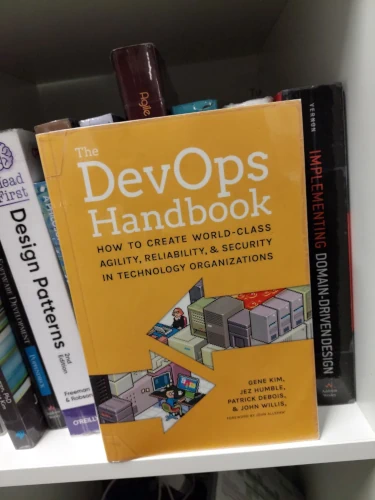The DevOps Handbook - review
Posted on 11 August 2023 in Books • 3 min read
I have started writing this review by describing the contents of each chapter in-depth, just to realize that it's hardly possible to do that without repeating the whole book. I usually put some conclusions at the end of a book review, but this book is different.
This is a short and emotional review of the DevOps Handbook: How to create world-class agility, reliability, & security in technology organizations.

For developers, programmers, craftsmen, and engineers, testers and architects, operations and security overseers, product managers, leaders, and many, many more - to all the exceptional IT professionals out there.
This is the book — the book that serves as a reminder of many things.
It reminds us that programmers are not mere machines that convert assignments into code. It underscores that QA professionals are not solely gatekeepers whose task is to extract bugs from the code programmers produce. It highlights that Operations personnel are more than overseers of programs functioning in production. It emphasizes that excelling as Project Managers is not about inundating products with requested features from customers. The book unites us in our shared objectives and reminds that ultimately value is created only when our customers can effectively utilize our product.
This is the book - the book that imparts to us the principles of flow, feedback, and continual learning and experimentation within the technology value stream.
The First Way: The Principles of Flow encompass the guidelines which help us to accelerate the progress of code, from the moment it was committed to the version control system, all the way until the customer is able to interact with it in a form of a software product.
The Second Way: The Principles of Feedback - are the guidelines that assist us in staying on the correct path. Are we truly addressing customer issues? Are we doing so efficiently? Is security ensured? Can we manage substantial customer loads? Are we addressing issues as they arise? Measure. Act. Analyze. Take action based on findings. Iterate. Apply this approach to every process, every hypothesis, and every segment of delivered software functionality.
The Third Way: The Principles of Continual Learning and Experimentation comprise the guidelines that aid us in maintaining a cutting-edge position and foster the creation of knowledge, both at an individual and organizational level.
The book begins by building a solid foundation out of these principles. It continues in Part II by discussing DevOps transformation, its starting points and ways to learn and experiment without jeopardizing the rest of the organization.
In Part III the author discuss the technical practices and architecture required to enable and sustain the fast flow of work from Development into Operations without causing chaos and disruption to the production environment or customers. These practices are commonly knows as Continuous Delivery.
In Part IV the authors discuss how to implement the technical practices of the Second Way, which are required to create fast and continuous feedback from Operations to Development.
In the last part - Part V, the book presents the practices that create opportunities for learning, as quickly, frequently, cheaply, and as soon as possible. This includes creating learnings from accidents and failures, as well as organizing and designing our systems of work so that we can constantly experiment and learn, continually making the systems safer.
Many of us have experienced some of these practices. I was fortunate in my career to grasp and adhere to the principles of flow and the principles of continual learning. However, I never had the opportunity to properly experiment or establish feedback mechanisms for such experiments, and I am still eagerly anticipating that chance.
This is the book. Get it. Read it. Embed everything you read in your daily work. Your colleagues, company and above of all, your customers will be grateful.